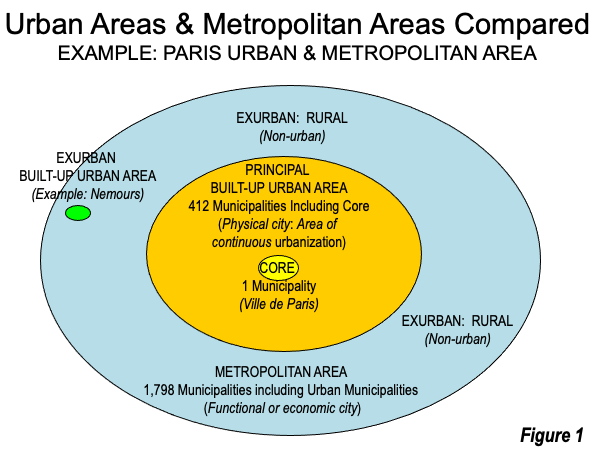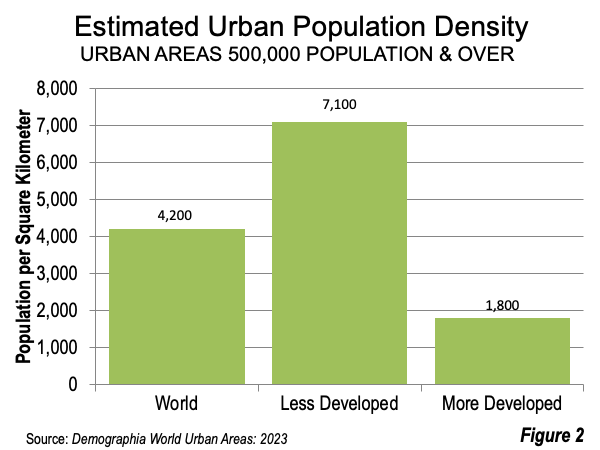
Defining "Built-Up Urban Area"
The term urban area refers to a continuously built landmass devoted to urban development. Unlike metropolitan areas, urban areas have no rural land within their boundaries. Similar definitions are used by national statistical authorities, such as in the United Kingdom (built up urban areas), Canada (population centres), the United States (urban areas) and Australia urban centres) and Scandinavian countries (urban areas).
Urban areas constitute "urban footprints," illuminated cityscape visible at night from an airplane or satellite. This continuous urban area is within the surrounding metropolitan region, but the two have very different definitions. This article is a summary of urban populations and densities in the nearly 1,000 urban areas with 500,000 or more residents, using data from the 19th edition of Demographia World Urban Areas.
Internal Variations in Density
Population density data for urban areas often masks significant internal variations. Within the same urban area, densities can range drastically. For example, North American Urban areas typically exhibit lower densities, sometimes below 400 people per square kilometer, whereas informal settlements (slums) can reach over 1,000,000 per square kilometer, such as in Dhaka, Bangladesh.
Comparing the Phoenix and Boston-Providence urban areas further illustrates this point in the American contest. It may seem surprising that Phoenix boasts a 60% higher average density than Boston-Providence. This is true even though the latter's highest density areas are at least five times as dense as those of Phoenix. Boston-Providence possesses a larger and denser central business district but its suburbs are far less dense than those in Phoenix. These internal variations are important to understanding the urban form. Despite its lower core densities in comparison to New York, Los Angeles' dense suburbs make it the most densely populated large urban area in the United States. This reflects the irony of the urban area most associated with "urban sprawl" factually being the least sprawling in the United States. Indeed, the San Jose urban area, nearly all of which is suburban, is denser than the New York urban area. Conversely, New York, despite much higher densities within the core, like the Boston area, sprawls over a larger area than any other urban area globally.
Similarly, London and Athens have comparable average densities, yet Athens boasts considerably higher core densities and much lower suburban densities. Likewise, the Essen-Dusseldorf and Milan Urban areas exhibit nearly identical overall densities, but Milan boasts a notably denser core.
The Difference Between Urban Areas and Metropolitan Areas
Urban areas are materially different from metropolitan areas, which are distinct entities. A metropolitan area represents a labor market (and coincidentally, a housing market), which includes the principal urban area, surrounding also economically connected rural areas and smaller urban areas outside the principal urban area.
Urban areas draw commuters from labor markets that are larger geographically. For instance, the Paris urban area encompasses 2,845 square kilometers, while the Paris metropolitan area spans 17,100 square kilometers, indicating that over 80% of the land area lies outside the urban area itself.
Similarly, in the United States, only 19.7% of land within metropolitan areas exceeding 1 million is classified as urban, with the remaining 80.3% being rural. The Canadian context further underlines this distinction, with 87% of land classified as rural within census metropolitan areas.
Due to their fundamental differences, it is generally inappropriate to make comparisons between urban areas and metropolitan areas. Comparing urban areas and metropolitan areas is akin to comparing apples and oranges (Figure 1).

Urban Densities by Extent of Development
In 2023, approximately 2.3 billion lived in nearly 1,000 urban areas with more than 500,000, at an average population density of 4,200 per square kilometer. About 555 million people — one–quarter of the urban population — lives in 249 urban areas in more developed regions. Their average urban population density is 1,800 per square kilometer.
The less developed regions include 1,752 million residents in 737 urban areas with more than 500,000 residents. The average population density of these urban areas is 7,100 per square kilometer. This is nearly four times the density in the urban areas of - more developed regions (Figure 2).

The highest urban densities at the national level are in Bangladesh (26,000) and the Democratic Republic of the Congo (17,000). This is considerably higher than in the more developed world. Urban areas in more developed nations generally thought to have dense urban areas are considerably less dense than in the less developed world, such as Japan, at 4,000) and Europe at 3,000 (Schedule 1 PDF opens in new tab or window).
The urban population densities in Japan and Europe are double to more than triple than those of Australia (1,500) and the United States (1,200). At the same time, the urban population densities of countries like Bangladesh, Nigeria, India, Pakistan and Indonesia are even higher compared to those of Japan and Europe, more than double to eight times as high (Figure 3).

Global Variations
Urban population densities constitute a diverse global picture, with significant variations between nations and, to a lesser extent within nations. This diversity often challenges common perceptions and underscores the need for tailored approaches to urban analysis.
Wendell Cox is principal of Demographia, an international public policy firm located in the St. Louis metropolitan area. He is a founding senior fellow at the Urban Reform Institute, Houston, a Senior Fellow with the Frontier Centre for Public Policy in Winnipeg and a member of the Advisory Board of the Center for Demographics and Policy at Chapman University in Orange, California. He has served as a visiting professor at the Conservatoire National des Arts et Metiers in Paris. His principal interests are economics, poverty alleviation, demographics, urban policy and transport. He is co-author of the annual Demographia International Housing Affordability Survey and author of Demographia World Urban Areas.
Mayor Tom Bradley appointed him to three terms on the Los Angeles County Transportation Commission (1977-1985) and Speaker of the House Newt Gingrich appointed him to the Amtrak Reform Council, to complete the unexpired term of New Jersey Governor Christine Todd Whitman (1999-2002). He is author of War on the Dream: How Anti-Sprawl Policy Threatens the Quality of Life and Toward More Prosperous Cities: A Framing Essay on Urban Areas, Transport, Planning and the Dimensions of Sustainability.
Photo: Buenos Aires (1986), Avenida 9th de Julio with the Obelisk in the center, by Nathan Hughes Hamilton via Flickr under CC 2.0 License.












